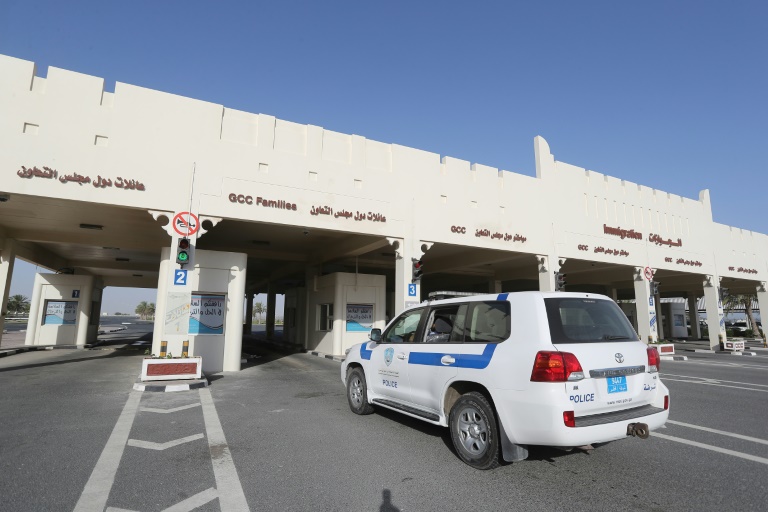Saudi crown prince embraces Qatar at summit to heal Gulf rift » Capital News
Qatar’s ruler Sheikh Tamim bin Hamad Al-Thani is given a warm welcome by Saudi Crown Prince Mohammed bin Salman on his first visit after three and a half years of broken relations, fueling hopes of rapprochement at a Gulf summit © Saudi Royal Palace/AFP / BANDAR AL-JALOUD
Al-Ula, Saudi Arabia, Jan 5 – Gulf leaders signed a “solidarity and stability” deal Tuesday after the leaders of Saudi Arabia and Qatar publicly embraced, bringing Doha back into the regional fold after a three-year rift.
Saudi Arabia had led a coalition of countries in the Gulf and beyond to cut ties and transport links with Qatar in June 2017, charging that it was too close to Iran and backed radical Islamist groups — allegations Doha denied.
Those countries, along with Oman and Kuwait which have mediated between the two sides, signed a rapprochement deal in the Saudi city of Al-Ula, after Riyadh overnight re-opened its land, sea and air borders to Doha.
“There is a desperate need today to unite our efforts to promote our region and to confront challenges that surround us, especially the threats posed by the Iranian regime’s nuclear and ballistic missile programme and its plans for sabotage and destruction,” said Saudi Crown Prince Mohammed bin Salman.
The Al-Ula Declaration “affirms our Gulf, Arab and Islamic solidarity and stability,” he told the meeting, in comments echoed by other leaders.
The details of the agreement were not immediately released, and analysts have said it could be preliminary and not immediately address all of the measures taken against Qatar.
But the warm welcome Prince Mohammed extended to Qatar’s ruler Sheikh Tamim bin Hamad al-Thani, with the pair embracing at the airport and then chatting animatedly, indicates a significant breakthrough.
Sheikh Tamim, visiting Saudi for the first time since the crisis began, was whisked with the other leaders through Al-Ula’s dramatic Martian landscape to the shimmering Maraya Concert Hall, a mirrored structure situated in a nearby valley.
Later, Saudi state media tweeted a photo of the young Saudi de facto leader behind the wheel of his sports utility vehicle, taking Sheikh Tamim on a tour of the area.
“These are first steps or a first phase of reconciliation that will be followed by other steps. Some may belittle that progress, but resuming open direct communication and avoiding verbal attacks is progress,” said Kuwait University assistant professor Bader al-Saif.
“The other states… will follow suit and pursue similar reconciliatory steps.”
– US cheerleading –
Washington had intensified pressure for a resolution to what Doha calls a “blockade”, insisting Gulf unity is necessary to isolate US foe Iran as the curtain falls on Donald Trump’s presidency.
Jared Kushner, Trump’s son-in-law and senior adviser who shuttled around the region to seek a deal, attended the signing in Al-Ula.
“The Trump administration will claim this as another victory for sure,” said Royal United Services Institute analyst Tobias Borck.
Kuwaiti Foreign Minister Ahmad Nasser al-Sabah announced on state television Monday that an agreement had been struck to open all the borders between Saudi and Qatar with immediate effect.
A lone police car surveys the closed Abu Samra border crossing between Qatar and Saudi Arabia in June 2017 © AFP/File / KARIM JAAFAR
Drivers south of Doha on the usually calm Salwa highway towards the Saudi border at Abu Samra sounded their horns and waved their arms from their car windows in the wake of the announcement, an AFP correspondent reported.
“We will see all Saudis here, also all Qataris will visit Saudi Arabia, and we will be friends as we were before and better,” said Hisham al-Hashmi, a Qatari with an Emirati mother, who wore a traditional thobe and winter headdress.
Saudi media, which is influential throughout the region, quickly adopted a tone in stark contrast to past coverage of Qatar which had focussed on past transgressions and alleged crimes, instead talking about “unity” and “fraternity”.
– Lingering resentment? –
The Saudi-led GCC hawks, along with Egypt, in 2017 closed their airspace to Qatari planes, sealed their borders and ports, and expelled Qatari citizens. An information battle raged online with the two camps trading barbs, deepening the resentments.
Some observers have warned that the United Arab Emirates could be the spoiler for reconciliation attempts, having heaped criticism on Qatar.
However, Prime Minister Sheikh Mohammed bin Rashid al-Maktoum, who is also the ruler of Dubai, said the summit had brought unity to the region.
“The changes and challenges surrounding us require strength, cohesion and real Gulf cooperation,” he tweeted.
Saudi King Salman chats with Qatari emir Sheikh Tamim bin Hamad al-Thani in Doha in December 2016, six months before the Gulf crisis erupted © Saudi Royal Palace/AFP/File / BANDAR AL-JALOUD
The UAE and Qatar in particular remain divided over Doha’s perceived support for movements aligned to the Muslim Brotherhood and the two countries’ backing for rival groups in the Libya conflict.
However, the diplomatic freeze has only served to make Qatar more self-sufficient and push it closer to Iran, observers say. It has also hurt Saudi strategic interests.
At the start of the crisis, the boycotting countries issued a list of 13 demands to Doha, including the closure of pan-Arab satellite television channel Al Jazeera, undertakings on “terror” financing, and the shuttering of a Turkish military base in Qatar.
Qatar has not publicly bowed to any of the demands.
burs-gw/sls/dv



